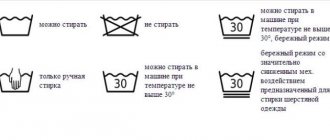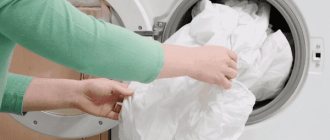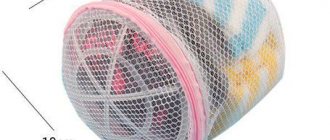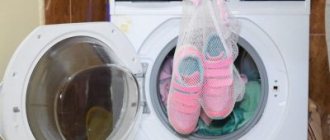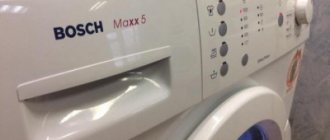“Iron with two points, basin with three” - what does this mean and how to use it?
Many people don’t even pay attention to the tag and calmly wash wool, corduroy and cashmere in the machine. Today we will tell you why you should not neglect the manufacturer’s care, how to choose the most correct cleaning method, what the icons on clothes , and in which cases it is better for you to seek help from specialists.
The symbols on the labels indicate acceptable types of care for clothing. They are compiled by manufacturers, based on the properties of the fabric from which it is sewn. Most often, icons are presented on tags in the form of pictograms developed in accordance with the standard of the international ISO system.
The icons are divided into 5 large groups:
| — shows the recommended washing temperature. |
| - indicates the recommended drying mode and water temperature. |
| — shows at what temperature to iron. |
| — allows the use of bleach. |
| — indicates to professional dry cleaning workers how best to clean your product. |
And 3 more important symbols:
| Horizontal underline | — it is recommended to use a softened processing mode. |
| Double underscore | - only delicate and gentle processing. |
| Crossed symbol | — a ban on the use of this processing mode. |
What are they needed for
Signs on clothes are a reliable guide for the housewife. Improper care gradually or immediately spoils the item, and even dry cleaning is not always able to help. To ensure that simple and delicate items last a long time and maintain their decent appearance, carefully read the manufacturer’s recommendations before purchasing and washing for the first time. What if your coat can’t be washed at all?
What happens if you don't follow the directions on the icons?
Designations on care clothing, the decoding of which suggests certain actions with it, help to preserve and look neat and beautiful when worn. It is not always possible to keep track of and sort dirty things into the right piles, in which case the following situations occur:
- Washing light colors with colored ones at a high temperature will cause staining or shedding.
- An incorrectly set iron setting can deprive you of your favorite silk blouse.
- If a wool sweater is dried on a line with a clothespin, it will lose its original shape forever.
- A cashmere coat should be professionally cleaned, as doing so at home will only damage the item.
There are many such nuances in life. Without paying attention to the small label, you will say goodbye to an expensive item. Modern automatic machines make maintenance much easier, because if you know how to read the care symbols, then setting the desired mode on the display is as easy as shelling pears.
Where to look for signs on things
Labels are usually sewn on from the inside out. On trousers this is the area of the hips, belt or pocket, on shirts - the side seam, skirts and dresses - the hem. Also, strips of fabric with markings are attached behind the collar. Pictograms are international symbols; the manufacturer is required to indicate them on each textile product.
Tip The location of the label is not always convenient: it either shows through or rubs. In this case, save or photograph the label after cutting it.
What are they for?
When purchasing outfits, most people do not look at the manufacturer's care recommendations. But in vain. For example, how are you going to clean a coat that only requires dry cleaning if you live in a small village where there are no such establishments? If you don't follow the rules, the item will quickly lose its attractiveness.
For good appearance and long service life, textiles must be washed with a suitable washing powder.
The symbols that are applied to the label are universal and are adopted in many countries at the legislative level. Therefore, they are mandatory in textile factories.
The label itself is a piece of fabric sewn to the product in an inconspicuous place on the reverse side. In addition to information on how to wash, it most often provides information about the manufacturer and composition of the fabric.
Many people cut off these tips because the tag can be uncomfortable to wear. In this case, it is better to save the label and return to the care instructions as needed.
To avoid turning your home into a warehouse of cut-off labels and to avoid getting confused about which item belongs to which, use this simple advice. Before cutting off the tag, take a photo of it together with the item, and it will be clear which dress or sweater it is sewn on. And when you need information, just find the photo you need in the memory of your phone or camera.
In the following sections we will get acquainted with the symbols that appear on the tags.
Washing: machine and hand
The symbol for any wash is a basin of water. If it is there and is not crossed out by two lines, then the product can be washed. How?
Let's take a closer look at the pelvis:
- There may be one or two stripes under the pelvis. One requires gentle washing and a gentle spin, two requires the most careful washing in a large amount of water and a quick spin. The stripes are sometimes combined with high water temperature, which means that you need to set the minimum time and slow drum speeds.
- The number inside the basin indicates the temperature of the wash water. Usually it is indicated from 30 - delicate wash, to 95 degrees - boiling.
- Another way to indicate water temperature is with dots. The more there are, the hotter the water is allowed. From one to six points are used.
- Exclusively hand washing for clothes is indicated by hand in a basin; such items cannot be washed in a machine. An empty basin can be safely thrown into the washing machine. Tumble washing is sometimes indicated by a picture of the appliance.
Tip The delicate wash symbols and low water temperatures also indicate the use of mild detergents.
Table 1. Icons showing how to wash the product
| Washable |
| Can't wash |
| Delicate wash at 40°C |
| Maximum gentle wash in cold water |
| Machine washable |
| Handwash |
| Hand wash cold |
| Wash in water 30 °C |
| Normal wash at 60°C |
| Can be boiled |
| Delicate wash in hot water |
General designations
One or two underscores are used with almost all icons and indicate delicate mode.
Crossing out with two lines is a clear prohibition.
Where can I find the label?
The first sewing factories led to the appearance of labels. At first the manufacturer's name was printed on them, then information for the consumer began to appear: how to wash, dry, and at what temperature to iron. The main information is what you should never do. Previously, tags were made of cardboard, now - on a ribbon or from soft fabric sewn into the inside of the collar. Information may be provided on the label, which is important to study before cutting and discarding.
Let's look at the main places where you can find a label on various items of clothing:
- jeans - the label is sewn on the side, at hip level. It may be located in the back seam location, below the waistband. Rarely, but sometimes the manufacturer sews a label into the pocket;
- sweater, jacket, cardigan - located in the side seam, below the collar, seam at shoulder level;
- dress - most often the tag is located closer to the hem, in the side seam. If the dress is made of knitwear, there may be a place under the collar - like a T-shirt.
Dry cleaning (dry cleaning and wet cleaning)
The circle indicates recommendations for professional dry cleaning. We decipher the letters and icons:
- Empty circle - dry cleaning is allowed.
- Crossed out - prohibited.
- Inside the letter “A” - cleaning with any solvent.
- Inside the letter “P” - procedures with hydrocarbons, ethylene chloride, and monofluorotrichloromethane are allowed. An additional horizontal line under the circle means a more gentle regime with the same solvents.
- Letter “F” - tetrachlorethylene and hydrocarbons are allowed. An additional feature is the delicate mode with the same solvents.
Don't bother with dry cleaning icons unless the circle is crossed out. A service employee will figure out how to clean a delicate item.
Table 2. Dry cleaning icons
| Dry cleaning allowed |
| Dry cleaning is prohibited |
| Any solvents |
| Regular or delicate whitening with substances approved for R |
| Regular or delicate whitening with substances approved for F |
“Water cleaning” is separately designated. You'll recognize these guidelines by the letter "W" inside the circle:
- No additions - water cleaning is allowed.
- A crossed out circle with a “W” or a crossed out filled circle means water cleaning is prohibited.
- One horizontal line under the circle is a gentle water cleaning.
- The double feature is the most delicate water cleaning mode.
Table 3. Icons for water cleaning
| Professional water cleaning allowed |
| Gentle water cleaning mode |
| Maximum gentle cleaning |
| Water cleaning is prohibited |
Dry cleaning
On the label, the dry cleaning icon is indicated by a circle. A detailed explanation of such symbols is presented in the table:
| Image | Designation |
| Dry clean only | |
| Dry cleaning prohibited | |
| Can be dry cleaned using any solvents | |
| Dry cleaning using hydrocarbons or trifluorotrichloromethane is allowed | |
| Gentle dry cleaning using hydrocarbons or trifluorotrichloromethane is allowed | |
| Delicate dry cleaning using hydrocarbons or trifluorotrichloromethane is allowed | |
| Dry cleaning with hydrocarbons, monofluorotrichloromethane and chlorine is allowed | |
| Gentle dry cleaning using hydrocarbons, monofluorotrichloromethane and chlorine is allowed | |
| Delicate cleaning with hydrocarbons, monofluorotrichloromethane and chlorine is allowed |
Also on the label you can see the image of a “W” in a circle. This symbol indicates the possibility of aqua-cleaning. The meaning of the icon can be seen in the photo:
The “W” symbol enclosed in a circle indicates that wet cleaning of the product is possible or prohibited.
Spin and dry
This category is indicated by a square. Let's look at some additional notation:
- A horizontal line in the center of the square means drying things on a flat horizontal surface. If there are two horizontal lines in a square, then it is not recommended to wring out the product.
- A vertical line inside a square - you can dry it on a hanger, rope or dryer. Two vertical lines - it is permissible not to wring out and hang immediately. Sometimes vertical drying is indicated by an arc at the top of the square, but this pictogram is obsolete.
- A crossed out square is usually found next to a crossed out pelvis. This means that the item cannot be washed, wrung out or dried.
- Additional stripes in the upper left corner of the square are a ban on drying in the sun (only drying in the shade is allowed).
- Circle inside a square - machine drying is allowed. A crossed out circle in a square means machine drying is prohibited.
- The dot in the circle (from one to three) indicates the drying temperature.
In addition to the square, the symbol of a twisted rope is used, crossed out by two lines. It means a ban on twisting the product during washing and spinning.
Table 4. Icons showing how to dry an item
| Can be wringed and dried |
| Tumble Drying |
| Spinning is prohibited |
| Tumble drying is prohibited |
| Normal or delicate drying, maximum temperature 60 °C |
| Normal or delicate drying, maximum temperature 80 °C |
| High temperature drying |
| Dry vertically, do not wring |
| Dry horizontally |
| Dry in the shade |
| Do not twist when spinning |
How can you tell if your soleplate is heating evenly?
Sometimes an iron will heat up some areas of the soleplate much more than others. This usually happens with older models. In this case, it is better to choose a temperature lower than recommended so as not to burn the fabric.
The heating of the sole depends on the material from which it is made:
- aluminum: heats up quickly, but not always evenly;
- stainless steel: fast, uniform heating;
- ceramics - holds temperature well, it is the same over the entire surface of the sole;
- metal with additional coating - can be Teflon, sapphire, etc.; improves heat transfer, ensures good glide, and uniform heating.
Polaris uses Smart Heat technology to make the sole heat up quickly and evenly. Calculation of the optimal thickness and shape of the soleplate, taking into account the power and location of the heating element, as well as the materials used, ensures optimal heat distribution for all Polaris iron models.
To ensure that the sole slides over the fabric and heats up quickly and evenly, Polaris uses specially designed coatings for it:
- anodized coating PRO 7 ANODIZED
- ceramic coating PRO 5 Ceramic;
- special coatings Easy-slide and GraphiTECH.
Ironing
Recommendations for ironing products are intuitive; the iron symbol is used for this. Explanation of symbols:
- One point inside the iron - iron with a warm iron, temperature up to 110 degrees. This designation is displayed on silk and wool products, for many synthetic samples.
- Two points - medium mode, temperature up to 150 degrees.
- Three dots mean a hot iron (up to 200 degrees), such ironing is recommended only for dense natural items. The dots match the markings on the iron, so you don’t have to worry about temperature readings.
- Two vertical lines from the sole of the iron allow you to use the steam mode.
- Crossed out iron - the fabric cannot be ironed at all.
- Crossed lines under the soleplate indicate dry ironing; steam cannot be used.
Table 5. Icons showing how to iron the product
| Iron at the minimum temperature of the iron sole, without steam. |
| Iron at iron sole temperature up to 150⁰C. |
| Iron at maximum temperature with steam. |
| Do not iron. |
| Do not steam. |
How can you find out the temperature of the iron?
Usually it corresponds to the value set by the thermostat. The temperature will be lower while the sole warms up. At this time, the indicator light will be on. It will go off after reaching the desired temperature.
To ensure accurate thermal control, Polaris uses state-of-the-art temperature sensors. They smoothly control the operation of the heating device, maintain the set temperature, ensuring efficient and safe ironing.
The minimum heating temperature of the sole is usually 75°C (for some models 115°C), the maximum is 205°C (may be higher with high power of the device).
To check whether the sole is warm, you can gently bring your palm to the sole, but do not touch it. When it is heated, it gives off noticeable heat. Another way is to try ironing a piece of cotton or linen.
Whitening
A triangle is used to indicate bleaching. An empty geometric figure indicates that the product will not be damaged by bleaching agents. Usually these are natural white fabrics.
Additional icons for the triangle:
- Two oblique lines inside the figure warn against the use of chlorine. Only oxygen compounds. The crossed out triangle with the abbreviation “Cl” inside indicates the same thing.
- A triangle icon with the letters “Cl” without a diagonal cross - feel free to use a chlorine compound.
- You should not bleach a product if there is a crossed out triangle on the label. Use a gentle stain remover.
Table 5. Icons showing how to remove difficult stains from a product
| Bleaching allowed |
| Do not bleach |
| No chlorine |
Letter marking
In addition to graphic signs, there are markings in English. Let's look at the meaning of these inscriptions.
Table 6. Translation of English symbols
| Hand wash only | Hand wash only |
| Machine wash | Machine washable |
| No wash or Do not wash | Can't wash |
| Don't dry clean | Dry cleaning is prohibited |
| Don't bleach | Do not bleach |
| Wash separately | Wash separately from other items |
| Don't iron | Do not iron |
| Don't wring or twist | Do not squeeze, do not twist |
| Don't tumble dry | Machine drying is prohibited |
| Dry in shade | Dry in the shade |
Additional unusual icons on things
In addition to standard care symbols, there are also unusual recommendations.
Table 7. A selection of rare pictograms and their meaning
| Dryer |
| Vertical loading |
| Withstands high humidity |
| Symbols for dry cleaning: short cycle, reduced humidity, low temperature, no steam finishing |
| Drying on a line or hanger |
As a joke, clothing manufacturers put messages on the tag such as "Superman T-shirt does not give the ability to fly," "Not edible" or "Give this to your mom, she'll figure it out."
Important Both washing, ironing and drying affect the appearance of textiles. Faded color after a couple of months of wear, pilling, frayed patterns - all this is a consequence of improper care of clothes.
Signs indicating conditions for ironing products
Following the recommendations from this block will allow you to quickly, efficiently and carefully smooth out wrinkles on the fabric and bring the product into shape after washing and drying. The following images are used:
- iron - ironing is allowed on standard modes;
- crossed out iron - ironing in manual or automatic mode is prohibited;
- iron with dots - with one - you can iron at a maximum temperature of 110C (nylon, nylon, viscose), with two - up to 150C (polyester, wool, natural silk), with three - up to 200C (linen, cotton);
- An iron with a crossed out steam sign means it is not recommended to steam the product.
Some general care tips
If you follow all the recommendations on the label, problems usually do not arise, but there are also additional tricks:
- Separate white, multi-colored, black and red - separately, these piles better retain their shade.
- Wash synthetics, wool and cotton separately, even if they are specified at the same temperature - they need different wash times, and the cotton lint wraps around the synthetic fibers, causing both materials to form pills.
- Be sure to check your pockets! Accidentally forgetting a notebook for notes after one wash will disfigure the entire load of laundry with small specks of paper crumbs, which will take a long time to clean off with a vacuum cleaner or clothes roller. And coins or nails will leave a legacy of rusty stains. The handles are not worth mentioning. These spots are unlikely to go away quickly.
- It is better to turn tights, socks, knee socks and generally all knitwear, including T-shirts, inside out - this way there will be fewer pills or they will hide on the inside out.
- Never wash clothes with shoes.
- If the item is delicate and has accumulated a lot of dust, so that a short cycle will not cope, do not add either time or washing gel - this will damage either the item or the device. Throw special laundry balls or 3-4 white tennis balls into the drum.
Features of the first wash
Instructions for the first washing of clothes from experienced housewives:
- For color: soak the item for several hours in paint protectant or saline solution.
- Dissolve the powder or gel well when hand washing.
- Wash the item separately from others.
- To check if the fabric is fading, wet a small area with warm water and wring it out. Sometimes the manufacturer includes a fabric sample along with the label, experiment with it.
All icons on the labels are conveniently structured, so now you won’t get confused in the basic designations. And complex additions can always be seen in this article.
How do you know what temperature to iron at if there is no label or markings on it?
Each fabric has its own ironing mode:
- cotton: 150 to 200°C, depending on thickness. If the material is mixed, with the addition of polyester, set 110°C;
- linen: 175-205°C or higher. The iron is turned on to maximum when the thickness is large, if the item is overdried or heavily wrinkled. Pure linen is easier to iron, additionally using steaming;
- wool: about 180°C with mandatory steaming. It is necessary to iron with care so that the fabric does not become deformed. This can only be done for woven wool garments (not knitted);
- silk: up to 160°C. Silk items should be ironed inside out. It is better to lay a thin damp cloth so that the item does not become deformed. Iron chiffon in the same way;
- viscose-based materials: up to 110°C dry, without steaming or wetting;
- velvet, plush: up to 110°C, from the inside out, through a thin, dry cloth, without moisture.
Some fabrics cannot be ironed or steamed at all:
- polyester;
- polyamide;
- terry items;
- nylon;
- materials with coffee, grease or other stains on them.

